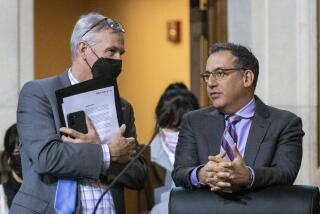The man behind L.A. City Council’s job cuts vote
The Los Angeles City Council delivered a jolt to the civic establishment last week, doing what some thought was unthinkable: demanding the elimination of 4,000 public jobs.
The vote took many in City Hall by surprise. Yet the seeds were planted months ago by a soft-spoken bureaucrat hired to help the city out of its financial sinkhole.
Since his arrival last summer, City Administrative Officer Miguel Santana has persistently pressed city leaders to embrace a series of unpleasant budget-cutting proposals. Last week’s vote, said Councilwoman Jan Perry, served as “an affirmation of all that he’s been saying.”
“His efforts sunk in,” said Perry, who favored the cuts.
Santana, 40, has quickly made his mark, spurring Mayor Antonio Villaraigosa and the council to take seriously the notion of slashing the size of the workforce, eliminating the smallest city departments and turning to private contractors to provide some public services.
Throughout that process, Santana -- who grew up in Bell Gardens, the son of a drywall installer -- has established a reputation for telling people what they don’t want to hear.
Before he was hired, Santana told Villaraigosa he would not accept the position if the mayor was planning to run for governor. Weeks later, he told the mayor and council members that they needed to collaborate more on the budget. And last month, he personally told the Human Services Commission, a panel created in the wake of the 1965 Watts riots, that the city could no longer afford its services.
That candor has drawn largely favorable reviews from his 16 bosses: the mayor and 15 council members. “I may not like what has been proposed so far, but I think he’s doing his job and doing it well,” said Councilman Jose Huizar.
Still, they don’t always take his advice. Last month, for example, his plan to ask voters to scale back the retirement benefits of newly hired workers was quickly tabled by Villaraigosa and the council. Meanwhile, critics have begun accusing him of trying to reshape City Hall in the image of the Los Angeles County bureaucracy, where he worked off and on over 15 years.
Councilman Richard Alarcon said Santana had been pursuing cost-cutting strategies like the county’s, such as hiring private contractors. And he questioned whether Santana was stepping beyond his role as an advisor who merely offers policy options.
“He seems to have an agenda,” Alarcon said. “And . . . I think he’s actually driving the car more than it appears.”
Santana, who lives in Claremont and has a wife and four daughters, said he leaves the decision-making to the city’s elected representatives. “My goal is not to make the city something else,” he said. “My goal is to make the city as strong as it can be.”
Santana was born in East Los Angeles, the third of eight brothers and sisters, raised by immigrant parents. When the family moved to Bell Gardens, they were the only Mexican Americans on their block. By the time he graduated from high school, the city was 90% Latino.
A graduate of Whittier College, Santana was hired in 1993 by the Mexican American Legal Defense and Education Fund as it attempted to respond to the Los Angeles riots. That job put him in contact with many of the city’s Mexican American politicians.
A year later, he became an aide to Los Angeles County Supervisor Gloria Molina, a politician also known for delivering unwelcome news -- but without the diplomacy. He stayed 13 years, acquiring much of his policy experience.
When the county was on the brink of bankruptcy in the mid-1990s, Santana fielded angry calls from Health Department employees who were subjected to the county’s arcane layoff process, which gives workers with seniority bumping rights over newer employees if their job is eliminated.
Although the process was chaotic, the layoffs helped county supervisors rebuild credibility as they sought a federal bailout for their healthcare system, Santana said. Reducing staff could play a similar role at City Hall, where officials are trying to persuade skeptical bond rating agencies that they are taking action.
“It certainly demonstrates that a government is doing everything it can to live within its means,” he said.
Santana was Molina’s chief of staff a decade later, when she and her colleagues took heat for another controversial vote: rejecting a proposed package of expanded retirement benefits for the county Sheriff’s Department.
Such benefits placed a huge pension burden on cities that adopted similar retirement packages. But at the time, the board’s refusal prompted threats of a recall and, later on, a search by labor leaders for candidates to challenge Molina.
“The board stood their ground,” Santana said. “Their strength came in their unity.”
Santana took a break from Molina’s office, getting his master’s degree in public administration from Harvard University. In 2007, he became a top executive in county government, overseeing social services. When Villaraigosa broached the subject of working for the city, Santana’s closest friends advised against it.
The city was already heading toward a fiscal meltdown, they said. He would have many bosses, some of whom were at odds with one another.
Molina says Santana may not have appreciated how difficult it would be to find solutions to the crisis that the city’s political leaders would accept. “He’s not unfamiliar with deficits, and he’s not unfamiliar with budgets. But I’m not just talking about the deficit. I’m talking about the ingrained culture of the city,” she said.
In January, Santana believed he had agreement between the mayor and five council leaders to cut 1,000 positions, part of the effort to address next year’s projected $484-million shortfall. That effort lost steam weeks later, with the council refusing to order the cuts.
That changed last week. After conferring with Santana behind closed doors, the council voted 9 to 3 to go even further, seeking the elimination of 3,000 jobs by July 1 on top the 1,000 already being discussed. Santana said even he was a little surprised by the council’s decision.
“What we’re asking folks to do is a difficult thing,” he said. “It’s not a small ask. And it’s part of the process to get folks to find their own way to accept it.”
david.zahniser
@latimes.com
Times staff writer Maeve Reston contributed to this report.
More to Read
Sign up for Essential California
The most important California stories and recommendations in your inbox every morning.
You may occasionally receive promotional content from the Los Angeles Times.











